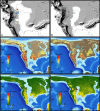Ecological niche modelling does not support climatically-driven dinosaur diversity decline before the Cretaceous/Paleogene mass extinction
- PMID: 30842410
- PMCID: PMC6403247
- DOI: 10.1038/s41467-019-08997-2
Ecological niche modelling does not support climatically-driven dinosaur diversity decline before the Cretaceous/Paleogene mass extinction
Abstract
In the lead-up to the Cretaceous/Paleogene mass extinction, dinosaur diversity is argued to have been either in long-term decline, or thriving until their sudden demise. The latest Cretaceous (Campanian-Maastrichtian [83-66 Ma]) of North America provides the best record to address this debate, but even here diversity reconstructions are biased by uneven sampling. Here we combine fossil occurrences with climatic and environmental modelling to quantify latest Cretaceous North American dinosaur habitat. Ecological niche modelling shows a Campanian-to-Maastrichtian habitability decrease in areas with present-day rock-outcrop. However, a continent-wide projection demonstrates habitat stability, or even a Campanian-to-Maastrichtian increase, that is not preserved. This reduction of the spatial sampling window resulted from formation of the proto-Rocky Mountains and sea-level regression. We suggest that Maastrichtian North American dinosaur diversity is therefore likely to be underestimated, with the apparent decline a product of sampling bias, and not due to a climatically-driven decrease in habitability as previously hypothesised.
Conflict of interest statement
The authors declare no competing interests.
Figures






References
-
- Sloan, et al. Gradual dinosaur extinction and simultaneous ungulate radiation in the Hell Creek Formation. Science. 1986;232:629–633. - PubMed
-
- Upchurch P, et al. Geological and anthropogenic controls on the sampling of the terrestrial fossil record: a case study from the Dinosauria. Geol. Soc. Lond. Spec. Publ. 2011;358:209–240.
-
- Brusatte SL, et al. The extinction of the dinosaurs. Biol. Rev. 2015;90:628–642. - PubMed

